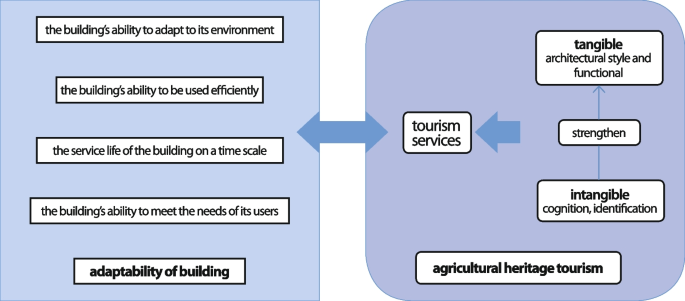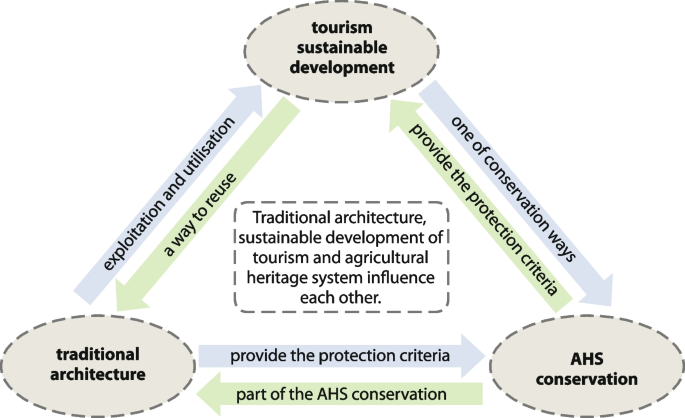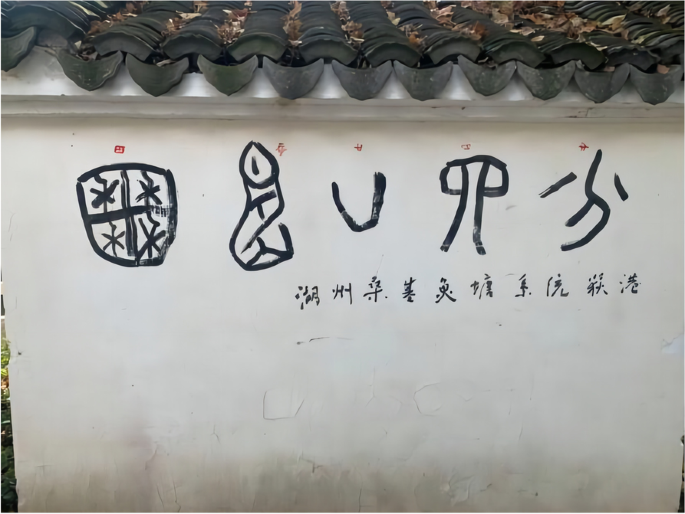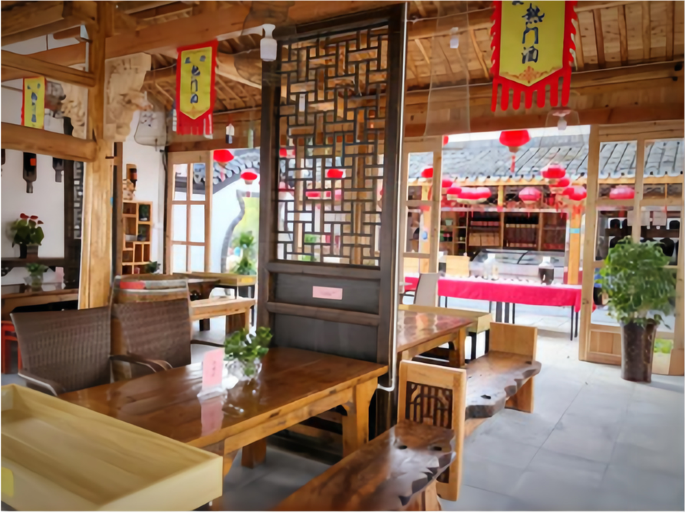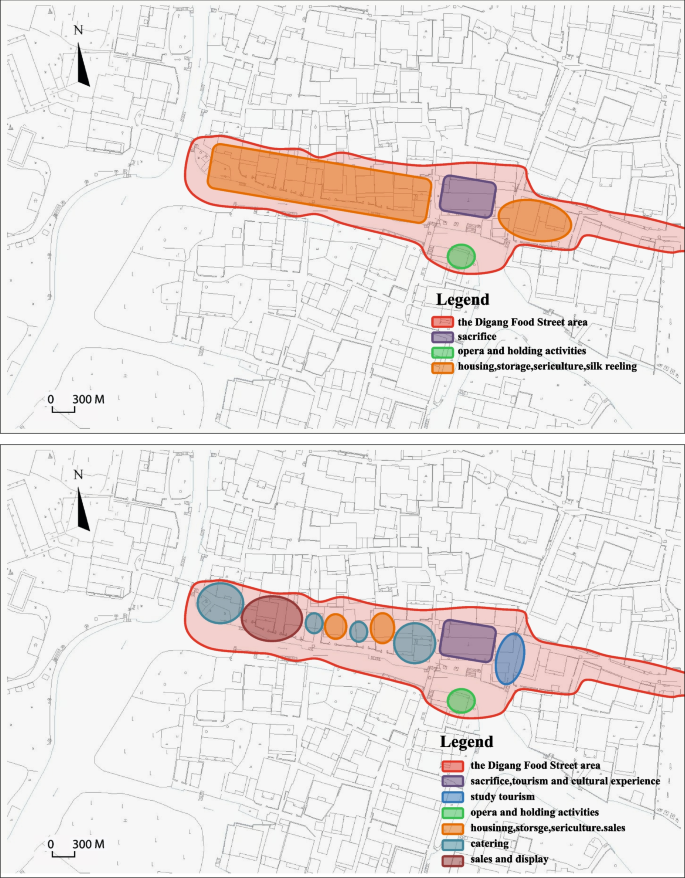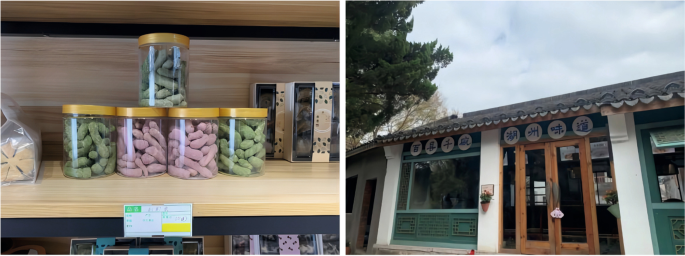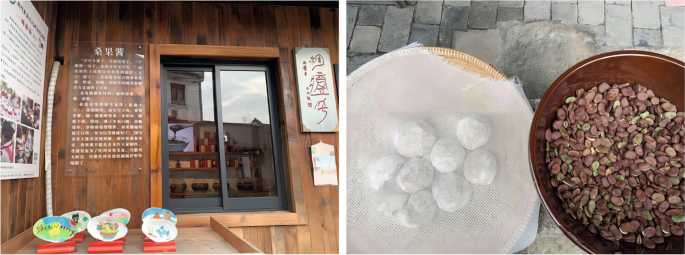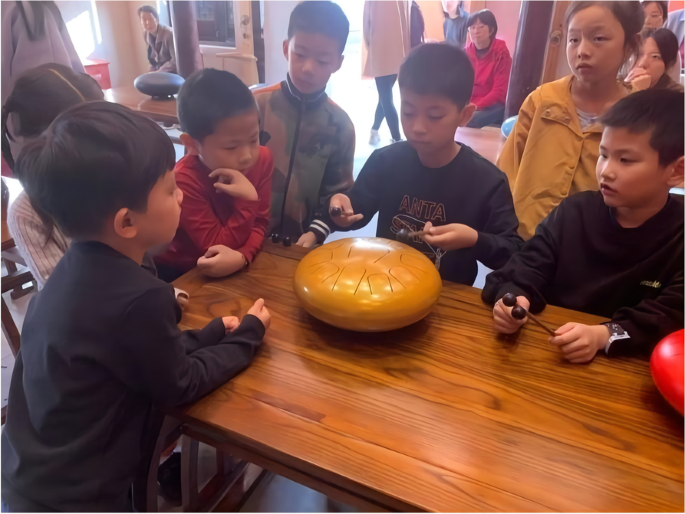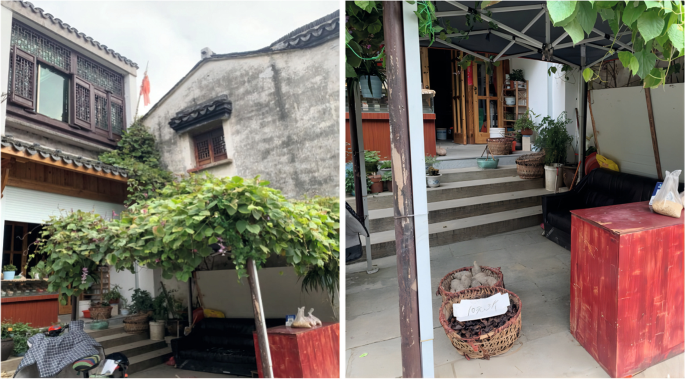- Research article
- Open access
- Published:
Study on the adaptability of traditional architecture in agricultural heritage sites after tourism intervention—a case study of Huzhou Digang Food Street in China
Built Heritage volume 6, Article number: 34 (2022)
Abstract
Traditional architecture in agricultural heritage sites (AHSs) embodies the livelihood of local communities and residents, which is an important part of the AHS. However, with the intervention of tourism, some of the traditional architecture in AHSs has gradually transformed into simple use for tourism, without reflecting the cultural connotations of agricultural heritage systems, as well as the farming wisdom of the AHS. This paper takes Digang Food Street in Huzhou, China as an example, which is in the core protection area of the Huzhou mulberry-dyke and fish-pond system, combining comparative analysis and geographical system analysis to explore the adaptive transformation in decoration, structure, spatial layout and functional form of buildings after the development of the tourism industry. The dynamic relationship among traditional architecture, sustainable development of tourism and conservation of agriculture heritage is also analysed, expecting to provide some experience and reference for the conservation of other AHSs.
1 Introduction
Since the rice–fish system in Zhejiang Province was listed as the first globally important agricultural heritage system (GIAHS) in China, the development of agricultural heritage tourism soon received attention. The conservation of agricultural heritage requires farmers to maintain traditional modes of agricultural production. Under the comprehensive influences of modernisation, urbanisation, scientific and technological progress and other factors, this traditional mode of production is facing the danger of being eliminated. It cannot satisfy the ‘win–win’ conditions of economic development and dynamic conservation of agricultural heritage systems. Sustainable tourism can realise the goal of preserving both the dynamic conservation of heritage and the economic interests of community residents, considered an inevitable approach to heritage preservation and development (Wang and Zhang 2016). Promoting the dynamic conservation of agricultural heritage systems (AHSs) through the development of tourism is one of the hot topics in recent years. The focus of the debate is whether the development of agricultural heritage tourism is conducive to the conservation of AHSs. The development of tourism can deeply tap into various agricultural functions, such as commodities, service and education. Various parts of the agricultural heritage system were commodified into tourist souvenirs for consumption through tourism development to make room for further agricultural development, expanding farmers’ major source of income beyond traditional agricultural production by offering food, accommodations and guide services to tourists, enriching the sustainable livelihoods of residents in heritage sites. The development of tourism up ends the dependence of traditional agriculture on natural elements and increases innovation and culture. Moreover, the development of agricultural heritage tourism can effectively drive the development of relevant industries with their supply chains and change the predominance of a single industrial structure in rural areas (Min and Sun 2009).
AHSs are rich in organic agricultural products, which are of great significance to human food safety and nutrition. Therefore, through the development of organic agriculture, the combination of many attractive tourism industries drives the growth of the local economy and improves the quality of life of local residents to promote the conservation of AHSs (Sun et al. 2006). However, it should not be ignored that tourism development plays a dual role. On the one hand, it deepens local communities' recognition of their own culture; on the other hand, tourism commercialisation distorts the true connotations of traditional culture, and foreign culture disturbs local social values and interferes with the normal inheritance mechanism of rural culture (Tang, Min, and He 2012). In addition, some scholars have pointed out that many farmers in rural areas have regarded tourism as an alternative industry to agriculture, gradually breaking away from and giving up traditional agricultural production and specialising in tourism. In fact, there is no evidence to show an obvious difference between rural tourism and agricultural tourism, and the original intention of heritage protection is lost in the development process, which violates the key purpose of agricultural heritage tourism development (Busby and Rendle 2000;Walford 2001).
Traditional architecture is the embodiment of information that reflects the agricultural evolution of heritage sites over thousands of years. It is the tangible basis for the development and evolution of heritage practices together with the architectural resources and the surrounding historical environment. Through traditional architecture, visitors can directly understand the development and change of heritage sites. In China, most of the AHSs are located in rural areas; some overlap with traditional ancient villages and historical and cultural towns (Su et al. 2019), and there are rich and diversified traditional buildings that reflect local characteristics in these places. In addition, most of the traditional buildings in the agricultural heritage area are residential houses, bearing signs of the modes of production and life of the region as an important expression of adaptation to the local living environment and ecological spirit (Min and Wang 2021). However, AHSs currently face problems of population hollowing out and an ageing labour force, leading to problems with uninhabited and idle traditional buildings in AHSs. Therefore, the reuse of traditional buildings is in urgent need of research and discussion. In addition, the development of tourism has squeezed the living and production space of local residents, and the space of heritage sites has changed and shifted. Can we find an appropriate way to adjust responses to the above problems to promote the sustainable development of tourism in agricultural cultural heritage sites? Based on the above research issues, the food street that transformed the core village of Huzhou in the mulberry-dyke and fish-pond system was considered as an example of how to effectively reuse traditional buildings and conduct sustainable development of agricultural heritage tourism.
2 Recent research on agricultural heritage tourism
2.1 The concept of agricultural heritage tourism
The use of agricultural heritage systems as a tourism resource has been recognised by the Food and Agriculture Organisation of the United Nations (FAO), and an increasing number of heritage sites carry out dynamic conservation and promote sustainable development through the development of tourism. Agricultural heritage tourism belongs to the category of cultural and heritage tourism in which the heritage site carries the important function of establishing the local cultural identity, reflecting the essential difference with rural tourism and agricultural tourism (Sun and Min 2013; Yotsumoto and Vafadari 2021). Tourists are supposed to systematically experience, learn and understand agricultural heritage, mainly including local traditional agricultural conservation and its related traditional technology and knowledge systems, ecological landscapes, agricultural biodiversity, unique culture and folk customs, and lifestyle, etc. (Tian et al. 2014) Agricultural heritage sites are expected to play a role in spreading educational and popular science, enhance the awareness of indigenous heritage conservation of all stakeholders through tourism products, tourism services and other tourism systems, and realise the transfer of traditional agricultural culture knowledge within and between generations through appropriate and captivating living interpretations of heritage (Sun 2018, 51). Some researchers put forward that agricultural heritage tourism can be regarded as a special form of heritage tourism that integrates the characteristics of agricultural tourism and ecological tourism (Wang et al. 2006). In addition, some scholars insist that agricultural heritage tourism emphasises tourists’ emotional response to and experience of the entire agricultural system and should provide ecological products related to agricultural production and agricultural system; this amounts to a form of ‘new tourism’ with a focus on heritage and emphasis on community participation (Su et al. 2020; Zhang, Hou, and Ma 2017). Obviously, neither the ecotourism model nor ‘new tourism’ should be destroyed at the cost of tourism development. As one of the approaches to the dynamic conservation of agricultural heritage systems, tourism should play a positive role under appropriate management.
Compared with the other types of heritage, agricultural heritage systems are more systematic and complex, emphasising biodiversity, traditional agricultural knowledge, technology and comprehensive conservation of agricultural landscapes, with highly distinct characteristics as a living practice. It is also a mode of economic and social production that requires human participation and reflects dynamic change in history. Agricultural heritage systems have been considered tourism resourcessince 2005 by the FAO. There sources in AHSs for tourism development are quite rich, including tangible and intangible elements in which traditional buildings are an important tangible resource not only for residents but also for outsiders (Wang et al. 2020).
2.2 Adaptability of traditional buildings in the tourism development of heritage sites
The transformation of traditional buildings often occurs in the process of rehabilitating and utilising them during heritage tourism development. Due to the influence of tourism, the sustainability of nature, culture and the local built environment is an important issue in the transformation of architectural heritage and traditional architecture. At the same time, tourism poses a potential threat to the natural and cultural transformation and adaptation potential of traditional architecture. Balancing sustainability and continuity in the transformation process is essential (Huang 2019). Che and Bao (2009) proposed the study of tourism development and morphological changes in traditional villages: ‘Against the background of tourism development, some traditional folk houses were changed to adapt to tourism development. The transformation of the use function of part or all of the space of the residence will eventually form a contemporary residence suitable for the functions required by tourists at that time and in a specific space and at the same time is able to meet the production and living needs of the indigenous residents.’ Lin (2014) proposed that in the context of ancient town tourism and heritage tourism, the evolution of Lijiang traditional residences to tourist spaces was reflected in several tangible aspects, including functional space evolution, structural transformation, and construction skills.
Adaptation, which first appeared in the field of biology, means to adjust and change. In the evolutionary theory of species, Darwin used adaptation to explain the relationship between the evolution of species and their living environment. Later, many scholars paid more attention to the unidirectional adaptation of organisms to their environment when studying adaptability. Zhang (2018) believes that the adaptability of architecture is the ability of buildings to meet the needs of users and adapt to changes in their environment through effective regulation and intervention to extend the life cycle of the building and promote sustainable development. ‘Transformation’ is the process of fundamental changes in the structural forms, operational models, cultural patterns, and values of things and is a long-term choice process (Yu, Sha, and Hu 2009). In this study, ‘tourism adaptation transformation’ refers to the transformation of the function, form, structure, construction mode and other tangible space and intangible culture of traditional architecture based on the demand or influence of tourism development (Fig. 1). The transformation of traditional architecture may be a simple function replacement, mainly to repair and transform; there has also been a fundamental shift with reconstruction and new construction dominating. In addition, ‘tourism adaptability transformation’ is often accompanied by ‘production and living adaptability transformation’, which not only meets the needs of tourists but also the contemporary production and life needs of indigenous residents.
The traditional architecture of AHSs is not only a tourism resource but also embodies the traditional agricultural production and lifestyle of the AHS. It is built by the residents of heritage sites adhering to the ecological concept of harmonious coexistence between man and nature, according to the local living environment. The forms are not limited to traditional houses and temples but also include some special functions, such as houses for mushroom and silkworm cultivation.
Therefore, the reuse of traditional architecture in AHSs is not only to study the reuse of architecture itself but also to focus the traditional knowledge and skills, local traditional folk culture and spiritual value. The dynamic circular relationship among the reuse of traditional architecture, sustainable development of tourism and conservation of agricultural heritage will be discussed in this paper (Fig. 2). First, traditional architecture provides a place and space for tourism development, and it is also a kind of tourist attraction. Sustainable tourism refers to the development of the tourism economy on the basis of the combination of environmental, social and economic effects without damaging the local natural environment and tourism resources (both existing and potential) (Yu, Sha, and Hu 2009). It points out possible directions for there use of traditional architecture but also the untouchable bottom line for traditional architecture. Second, the sustainable development of tourism is an important method for the dynamic conservation of agricultural heritage systems. Moreover, traditional architecture is itself an important component of the agricultural heritage system.
3 Research design
3.1 Digang Food Street project
The Huzhou mulberry-dyke and fish-pond system is a traditional compound agricultural production model created by utilising water and soil resources. It has the characteristics of high economic and ecological benefits, which are common in the eastern and southern water network areas of China. The system is one of the largest and most complete traditional agricultural systems in China. The main part of the system is located in the western part of the Nanxun district of Huzhou city, Zhejiang Province. In June 2014 and November 2017, the Huzhou mulberry-dyke and fish-pond systems were selected as NIAHS and GIAHS systems, respectively.Digang Food Street is located in Digang Village, which is the core conservation area of Huzhou mulberry-dyke and fish-pond system. The houses in the village are mainly representative of traditional architecture, and was named the traditional ancient village in 2013. The food street is a sample of ‘micro-transformation and refined promotion’ created by Digang Village. It has been transformed according to the style of the original residential houses. The decrease in the rural resident population has led a large number of traditional dwellings to sit idle. The intervention of agricultural cultural heritage tourism has realised the reuse of idle traditional dwellings. Digang Village has transformed and upgraded some of the shops along the street in the village through recycling idle houses, partial demolition and construction, decoration design, and environmental beautification. The village also created a unique venue for Digang tourism—the food street (Fig. 3). The food street has 12 shops, 1 ancient temple, and 1 stage, etc., mainly selling popular wine, local noodles (San Wan Mian in Chinese), Sandao Cha (a local tea, including sweet tea, salty tea, and bitter tea) and other characteristics of Digang food. The street is strategically located along the river, as the second expansion of the silk town project, but the residential houses on the other side of the river have not been renovated and upgraded.
3.2 Data collection
Based on adaptation theory, the researchers mainly collected data on the decoration, structure, spatial layout and functional form of food streets before and after the tourism intervention, as well as relevant information on adapting to the change.
The tangible changes to architecture, including architectural style, decoration, structure and function, are mainly extracted from the current situation through in-person investigation. The information before tourism intervention was obtained through typical interviews, and high-resolution remote sensing images of tangible changes were analysed in a building-by-building comparison.
Intangible changes to architecture, include community residents' attitudes towards tourism development and cognition and conservation of agricultural heritage systems. Their views on traditional architecture changed, mainly through in-depth interviews. The interview questions were mainly about the understanding of food streets before and after the changes to buildings and careers, the attitude towards tourism development, and opinions of agricultural heritage conservation. Within the study area, 14 people were interviewed in depth (Table 1). Data about intangible changes were obtained directly through interviews.
4 Adaptability of traditional architecture on Digang Food Street
4.1 Tangible adaptive transformation
The adaptive transformation of traditional buildings on the tangible level can be divided into three categories: transformation, reconstruction and new construction (Fig. 4). Transformation entails retaining the original building space layout and space organisation and only making changes to the building function and part of the form, with minimal impact. Reconstruction is performed to demolish and rebuild the original building partly or completely, but the building follows or basically follows the original pattern and form. New construction is accompanied by the emergence of new architectural patterns and forms (Huang 2019). This study found that the qualitative adaptation of the traditional buildings on Digang Food Street involved only reconstruction and mini- or micro reconstruction; since there was neither reconstruction nor new construction, tourism intervention made little change to the traditional buildings. From the perspective of tourism development, tangible adaptation is better.
4.1.1 Architectural style and decoration
After the development of tourism, traditional architectural style and decoration changed from simple to diverse. Most of the original traditional houses are dilapidated forms of the Jiangnan style (also called the style of south of the Yangtze River). These buildings gradually were adapted to have an architectural style similar to that of Digang Village. The overall decoration of white walls and black tiles remained unchanged. The exterior wall is painted with elements and symbols related to the Huzhou mulberry-dyke and fish-pond system (such as calligraphy and painting, folktales, popular science knowledge of fish and tourist signs, etc.,which you can see in Fig. 5). The decoration of doors and windows of the buildings has become brown and retro (Fig. 6). The interior decoration changed from an original design for home life into a space for shop products related to the decorative style and decorations and instruments from the local production cultures (such as silk reeling tools, sericulture tools, farming tools, etc.) into a variety of souvenirs.
4.1.2 Functional transformation of traditional architecture
Before the development of tourism, Digang Food Street held only traditional residences used by the residents of the heritage site (Table 2, Fig. 7(a)). Its main functions included living, storage, sericulture, silk reeling, prayer and sacrifice. After the intervention of tourism, the local traditional buildings were transformed into special food courts, catering areas, mulberry pond-related souvenir shops, tourist-oriented study activity areas and festival areas, which caused the original functions to be lost (Table 2, Fig. 7(b)). The service object of traditional architecture is changed from local residents to tourists, and their functions are also diversified. In addition, there is a residence that retained most of its original functions, and increased only its ability to sell things. There are some landmark buildings, such as the Sanguan Temple, which had tourism-related functions added.
(1) Product is play, sales and catering functions
On Digang Food Street, there are 6 specialty stores and workshops for mulberry-dyke and fish-pond system agricultural products and derivative products, such as Mulberry Time, which mainly sells mulberry leaf cake, mulberry yellow crisp, Husang tea and other derivative products developed locally and independently. A silkworm sauce shop sells mulberry jam and local characteristic sauce and other products, including Sandao tea and souvenirs with characteristics of local agricultural products. There are also shops selling many bowls representative of hundreds of counties, mulberry pond fish, local noodles, and popular wine in Digang, which provides catering for foreign tourists (Fig. 8).
(2) Interpretive and educational functions
The essence of agricultural heritage tourism is helping to increase popular knowledge of education and science. The goal is to protect agricultural heritage and promote the development of agricultural heritage sites. The agricultural heritage elements related to the Huzhou mulberry-dyke and fish-pond system can be seen everywhere on Digang Food Street. In addition to selling products and providing basic services, each shop has its own products in front with an explanation card or video playback and also displays the production of tools for visitors to experience (Fig. 9). The local tourism operators also carried out centralised training for staff, requiring them to produce relevant products. For example, in the Mulberry-Pond Fish Experience Hall, the explanatory plaques about the connotations of agricultural heritage systems can be seen, as well as the ecological breeding and characteristics of the mulberry pond fish and photos of the expert team of the Huzhou mulberry-dyke and fish-pond system. This kind of ‘informal’ popular science and education enhances foreign tourists’ knowledge and understanding of agricultural heritage systems. Digang Food Street also set up a fish mulberry farming reading hall. Special time is set aside for local primary and secondary school students to learn fishing songs and other local traditional culture courses monthly to cultivate conservation awareness into the next generation for the mulberry-dyke and fish-pond system (Fig. 10). In addition, Digang Food Street is the main venue for the Huzhou Fish Culture Festival every year. The fishing culture festival has ‘Shuishangshaiqiu’ activities (a ceremony to celebrate the harvest), silk reeling technology display, fish tasting, eating fish soup with rice and other activities.
4.2 Intangible adaptive transformation
After the intervention of tourism, the tangible changes to the traditional buildings at the agricultural heritage sites will cause intangible changes, including changes to the traditional building user (the transformation of social subject), change in the degree of community residents’ participation in tourism development, changes in the cognition and conservation of agricultural heritage by community residents, as well as the intangible changes. The relationship between tangible and intangible space is actually an interaction between the natural environment and the human environment. The natural environment determines the form of the tangible space of traditional architecture, while the human environment endows traditional architecture with intangible cultural connotations (Huang 2019).
4.2.1 Community participation in tourism
Before the development of tourism, the ownership and use of traditional buildings belonged to community residents. After the tourism intervention, tourism operators sign use contracts with community residents to transform and reuse traditional buildings and transfer the use rights to operators. The reuse of traditional buildings provides more employment opportunities for the residents of heritage communities and allows them to participate in the tourism development (tourism services) of agricultural heritage sites in rural areas (Table 3), places that normally have relatively low economic development. Traditionally, in a rural place without a tourism intervention, most of the male labour force goes out to work to seek a better livelihood, and women take care of the family at home for the greater part of their lives. In Huzhou mulberry-dyke and fish-pond system, the community residents who participate in tourism development are mostly female. According to the survey results, there are approximately 24 female staffers and only 2 male staffers on Digang Food Street, and they are all local residents from Digang Village or nearby. They are trained by tourism operators in tourism communication etiquette, sales skills, product-related knowledge, and basic information about the mulberry-dyke and fish-pond system, making them salesmen, food and beverage shop service personnel, and research instructors, etc. They are transformed from the original occupants into tourism managers or service staff, with practical abilities to participate in tourism services and enhance tourism participation.
4.2.2 Residents’ cognition of agricultural heritage and changes in conservation behaviour
The adaptive change of the traditional buildings in agricultural heritage systems causes the community residents to have new perceptions about the building itself, agricultural resources, farming culture and ecological environment. The development of tourism has also led local residents to view their own lives and culture in a new light. In this study, in-depth interviews with tourism operators and some tour participants on Digang Food Street revealed that the adaptations to traditional architecture make it a new tourist attraction (Table 4). The new tourism highlights have promoted the research, development and sales of related tourism products, such as mulberry-pond fish, mulberry silk, Chen cuisine, fish culture festivals and so on, and enhanced their awareness of local resources.
During the interview, Mrs. Zhang (54 years old, female, catering service) said, ‘The food street has led to the development of tourism in Digang Village, and we can also find jobs in the fishing village. Originally, we raised fish. Now, we usually make our own fish balls, rice cakes and other tourist foods’. In addition, the Digang fishing village resort organised professional training and held agricultural heritage meetings to enhance community awareness of the value of the mulberry-dyke and fish-pond system. Through the continuous iteration of a tourism product, the inclusion of young people also led to the better understanding of the ‘younger generation’ of the region of the mulberry-dyke fish-pond culture and experience. A sample question from the interviews included ‘are you satisfied with the renovation of the food street project?’ The results of interviews with staff on Digang Food Street show that most of them are satisfied with the food street project, happy that the original dilapidated house has been transformed into a distinctive shop, pleased that the street sanitation is also significantly improved, and satisfied that the quality of life has been enhanced.
At the same time, traditional architecture transformation can have a negative impact. The reuse of traditional architecture has reduced or shifted the production and living space of locals, and the production space associated with traditional techniques such as sericulture and silk reeling has decreased. The occupation of community residents changed from agricultural producers to tourism service personnel, which to some extent reduced the number of traditionally skilled culture practitioners in some heritage sites. In the long run, this will have a negative impact on the sustainable development of the Huzhou mulberry-dyke and fish-pond systems. In addition, some community residents choose to rent traditional houses to tour operators and go to the city to buy houses. The living environment has changed to a great extent, and some local customs such as ‘Shuishangshaiqiu (a ceremony to celebrate the harvest)’ face the threat of disappearing as traditional sacrificial activities will be omitted.
4.2.3 Some special cases
The rapid intervention of tourism is an important driving force for the transformation of traditional architecture in agricultural heritage sites, which involves local governments, tourism operators, community residents, tourists and other stakeholders. However, when the demands of stakeholders are inconsistent, conflicts will appear; to a certain extent, these conflicts will lead to the emergence of some traditional buildings in the heritage sites that have not changed tangibly but have undergone intangible changes. Focusing on Digang Food Street, there are still two local families living there. The traditional houses are not consistent with the decorative style after the transformation, and the interiors have not been rearranged, so the overall style is not harmonious. This kind of residential function has not completely changed; the houses retain the community residents’ production and living functions but also add some product sales functions (Fig. 11). A sense of local identity as the resident of a heritage sites was enhanced through contact with tourists by observing the tourists’ behaviour and selling local products and crafts, which brought home to locals the value of living in the heritage sites.
5 Discussion
The traditional architecture in agricultural heritage sites is the product of the adaptation between residents and the surrounding natural environment. It should not only protect the extant traditional architecture but also protect the existing traditional agricultural culture. In essence, the process of conservation and reuse of traditional architecture should follow the principles of authenticity and integrity in the transformation process. The demolition and reconstruction of buildings is usually used only on unused buildings or those where the construction quality has degraded, and then new buildings are built in a similar style as the surrounding environment. This architectural cycle is a process of reusing and activating space. The principles of respecting traditional culture, promoting industrial development, shaping local characteristics and adapting to future development should be followed in the reconstruction process.
The adaptation of traditional architecture is a lengthy and drawn-out process. Digang Food Street is at the initial stage of development. The invasion of tourism development and the investment of capital by tourism operators forced locals to change, encroaching on their production and living space and causing some residents give up their traditional agricultural production methods. Many residents became tourism practitioners (Zhu, Zhang, and Li 2021) to coordinate the relationship between residents and tourists and to reasonably plan tourism space and living space (Wang and Li 2013). In addition, if heritage managers and tourism operators have different understandings of heritage value after tourism intervention, it is easy to lose sight of the value of the landscape, environment, society and culture of cultural heritage. Heritage managers and tourism operators at agricultural heritage sites should fully realise that the effective protection of heritage sites is a prerequisite for sustainable tourism development. In the process of making use of traditional architectural heritage for tourism adaptation, heritage protection should be the core prerequisite. Heritage managers aim for the long-term preservation and sustainable development of heritage, while tourism operators aim for short-term direct economic benefits. The two should establish a good cooperative relationship in economy and policy. Conservators should also implement knowledge and skills training for tourism operators and social groups to improve the awareness of cultural heritage. In addition, community residents should be given priority in the protection of agricultural heritage and should not be excluded from local heritage practices (Zhang 2022). Policy-makers should considerenrichingthelivelihoodsoflocalresidentsandenhancingcommunity participation as metrics for the development of heritage sites to enhance their sustainability.
In addition, the traditional buildings discussed in this case take only Digang Food Street as an example. Most buildings were abandoned and recycled in a way that does not involve the living situation of most community residents. In fact, the traditional architecture of agricultural heritage sites also includes temples with spiritual beliefs, specific architectural forms with production functions, and community residents living in the heritage site for generations. The adaptability of the traditional architecture of agricultural heritage systems in modern society includes not only the ecological adaptation of architecture to the environment but also the process of social adaptation, which endows traditional architecture with new functions and meanings. From the perspective of heritage protection, the reuse of traditional architecture has advantages and disadvantages. Reasonable transformation and utilisation are not only conducive to the protection and inheritance of agricultural heritage systems but can also improve the quality of life of the residents of the heritage site and improve the residents' sense of identity with the local culture (Xiao and Yang 2017). On the other hand, unreasonable reconstruction will bring pressure to protect ancient houses and counter productively destroy the tourist experience of traditional culture (Lu et al. 2004). Therefore, the reuse of traditional agricultural heritage buildings cannot be assumed to be ‘one size fits all’. Eliminating or replacing the original function of traditional architecture according to the function and form of the traditional architecture is not in line with the dynamic protection principle of agricultural heritage systems. For this kind of traditional architecture, we can carry out small-scale tours focused in-depth on heritage experience or study, which will not involve the destruction of the way of life for all the residents of the heritage site, only renovation of the traditional architecture itself. In this way, the risk of losing local folk culture is prevented.
6 Conclusion
Traditional architecture is an important part of agricultural heritage systems, as sites for the production and daily activities of local residents from the heritage area, who maintain the local culture and traditional practices of farming. On the one hand, the development of tourism has promoted the social and economic prosperity of the heritage sites, but it has also brought about local spatial transformation, such as there location of residents' living space, which is an invalid use of traditional architecture and a compromise to tourists. On the other hand, some of the agricultural heritage sites are hollowed out by migration, and some traditional houses and buildings are shelved, resulting in the waste of resources. Moreover, agricultural heritage tourism bears the responsibility for the popularisation of food science and education.
Due to the involvement of tourism development in Digang Food Street in Huzhou city, the traditional architecture has been transformed from the original residential houses of community production and life into shops and workshops selling agricultural products and related derivatives of mulberry fish-ponds. The architectural decorations are retro-style, with modern ornamentations. The change in function and the realistic demand for tourism development have caused intangible changes among users of the space, the participation of community residents in tourism development, and the cognition and conservation behaviour of community residents regarding agricultural heritage. The study found that the reuse of traditional buildings on Digang Food Street provides a place for tourism development and provides a new way for community residents to be employed and participate in tourism development. To a certain extent, residents’ participation in tourism enhances their awareness of local culture and their willingness to protect it. However, their awareness is relatively one-sided, limited to their own activities, and lacks a relative overall objective and systematic understanding. It should be fully realised that in the process of transforming traditional architectural heritage for tourism purposes, heritage protection should be the core prerequisite. At the same time, the change in function also compresses the original community production and living space, which is not conducive to the inheritance of traditional agricultural heritage skills. Therefore, it is necessary to rationally plan for both the tourism space and the production and living space. On the whole, Digang is a good attempt to combine the reuse of traditional architecture, sustainable tourism development and the protection of agricultural heritage systems through the effective use of idle buildings.
Availability of data and materials
Not applicable.
References
Busby, G., and S. Rendle. 2000. The transition from tourism on farms to farm tourism. Tourism Management 21 (6): 635–642.
Che, Zhenyu, and Jigang Bao. 2009. Research on tourism development of traditional villages and the change of form. Planners 22 (6): 45–60.
Huang, Chengmin. 2019. Study on the tourism adaptability transformation of vernacular architecture in cultural heritage settlement—A case study of Shanxi ancient town in Jianchuan County of Dali prefecture. Master’s thesis, Kunming University of Science and Technology.
Lin, Minfei. 2014. The transformation study from folk houses to tourist houses-a case of Lijiang. Master’s thesis, Kunming University of Science and Technology.
Lu, Song, Lu Lin, Li Wang, Yong Wang, Dongdong Liang, and Zhao Yang. 2004. Temporal characteristics of tourist flows to ancient villages–A Case Study of Two World Cultural Heritages, Xidi Village and Hongcun Village. Scientia Geographica Sinica 24 (2): 250–256.
Min, Qingwen, and Bojie Wang. 2021. Innovation with integrity: Home-stay-tourism in agricultural heritage sites and its development path. World Architecture 8 (08): 12–14, 126.
Su, Mingming, Yuanzhou Dong, Geoffrey Wall, and Yehong Sun. 2020. Avalue-based analysis of the tourism use of agricultural heritage systems: Duotian agro-system, Jiangsu Province, China. Journal of Sustainable Tourism 28 (12): 2136–2155. https://doi.org/10.1080/09669582.2020.1795184.
Su, Yingying, Yehong Sun, Qingwen Min, and Ying Wang. 2019. Discussion on tourism management mode in villages of China’s agricultural heritage sites. Chinese Journal of Agricultural Resources and Regional Planning 40 (5): 195–201.
Sun, Yehong. 2018. Disaster risk cognition and adaptation of tourism community in agricultural heritage sites. Beijing: China Environmental Publishing Group.
Sun, Yehong, and Qingwen Min. 2013. Kechixu lüyou: nongye wenhua yichan wenhua jiazhi shixian de zhuyao tujing [Sustainable tourism: The main ways to realize the cultural value of agricultural heritage]. Farmers Daily, October 11.
Sun, Yehong, Qingwen Min, Shengkui Cheng, and Xuhai Wang. 2006. Relationship between tourism resources development and regional social and economic development in agricultural heritage site—Taking “traditional rice- fish agriculture” of Qingtian county as an example. Resources Science 28 (4): 138–144.
Sun, Yehong, and Qingwen Min. 2009. The Concept, Characteristics and Conservation Requirements of Agro-cultural Heritage. Resources Science 31 (06): 914–918.
Tang, Xiaoyun, Qingwen Min, and Lu He. 2012. Measurement and regulation of socio-cultural impact of tourism in agricultural heritage site-A case study of LongjiPing’anzhai Terrace in Guilin, Guangxi. Chinese Journal of Eco-Agriculture 20 (6): 710–716.
Tian, Mi, Qingwen Min, Hui Tao, Zheng Yuan, Lu He, and Fei Lun. 2014. Progress and prospects in tourism research on agricultural heritage sites. Journal of Resources and Ecology 5 (4): 381–389.
Walford, N. 2001. Patterns of development in tourist accommodation enterprises on farms in England and Wales. Applied Geography 21 (4): 331–345.
Wang, Gang, and Na Li. 2013. The geographical traditional architectural landscape renewal in the context of tourist consumption. Southeast Culture 6: 19–23.
Wang, Min, and Lu Zhang. 2016. The influence of agricultural heritage tourism on rural economy. Journal of Lanzhou University of Arts and Science (Social Science Edition) 32 (4): 64–68.
Wang, Xin, Qingwen Min, Dianting Wu, and Xuhai Wang. 2006. Tourism development research on globally important ingenious agricultural heritage systems (GIAHS) —A case study on traditional Rice-fish agriculture of Qingtian. Areal Research and Development 25 (5): 63–67.
Wang, Ying, Yehong Sun, Yingying Su, and Wenjun Jiao. 2020. Research on agricultural heritage tourism interpretation resources based on community participation—A case study of rice-fish system. Tourism Tribune 35 (5): 75–86.
Xiao, Juan, and Yongqing Yang. 2017. Landscape of traditional settlements in eastern Sichuan based on ecological adaptation. Acta Ecologica Sinica 37 (13): 4529–4537.
Yotsumoto, Yukio, and Kazem Vafadari. 2021. Comparing cultural world heritage sites and globally important agricultural heritage systems and their potential for tourism. Journal of Heritage Tourism 16 (1): 43–61.
Yu, Xiangyang, Run Sha, and Shanfeng Hu. 2009. Criticism and research on sustainable tourism. Economic Geography 29 (12): 2090–2095+2084.
Zhang, Aiping, Bing Hou, and Nan Ma. 2017. Community residents’ perception of tourism impacts and their participation attitude in agricultural heritage sites ——a case study of Hani Terrances. Human Geography 32 (1): 138–144.
Zhang, Feng. 2018. Research progress in interpretation and core theory of architectural adaptive design. Housing Science 38 (3): 37–42. https://doi.org/10.13626/j.cnki.hs.2018.03.009.
Zhang, Su. 2022. Agricultural heritage tourism development and heritage conservation: a case study of the Samaba Rice Terraces, Yunnan, China. Journal of Heritage Tourism 17 (3): 357–370. https://doi.org/10.1080/1743873X.2022.2028793.
Zhu, Xuanbo, Jiaqi Zhang, and Keqiang Li. 2021. Influence mechanism of tourism development in traditional ethnicVillages in the context of rural revitalization. Jiangxi Social Sciences 41 (3): 229–237.
Acknowledgements
The authors all thank Minli Xu from Huzhou Digang Fishing Village Resort for the support for data collection. Specially thanks the Lijing Lou, Jiafang Li for their support for the investigation.
Funding
This work was supported by funding from the National Natural Science Foundation of China (to Yehong Sun) (No. 41971264), Graduate Research and Innovation Funding Project of Beijing Union University and Premium Funding Project for Academic Human Resources Development in Beijing Union University (To Yehong Sun).
Author information
Authors and Affiliations
Contributions
All authors read and approved the final manuscript.
Corresponding author
Ethics declarations
Competing interests
The authors declare that they have no competing interests.
Additional information
Publisher’s Note
Springer Nature remains neutral with regard to jurisdictional claims in published maps and institutional affiliations.
Rights and permissions
Open Access This article is licensed under a Creative Commons Attribution 4.0 International License, which permits use, sharing, adaptation, distribution and reproduction in any medium or format, as long as you give appropriate credit to the original author(s) and the source, provide a link to the Creative Commons licence, and indicate if changes were made. The images or other third party material in this article are included in the article's Creative Commons licence, unless indicated otherwise in a credit line to the material. If material is not included in the article's Creative Commons licence and your intended use is not permitted by statutory regulation or exceeds the permitted use, you will need to obtain permission directly from the copyright holder. To view a copy of this licence, visit http://creativecommons.org/licenses/by/4.0/.
About this article
Cite this article
Wang, Y., Sun, Y., Gu, X. et al. Study on the adaptability of traditional architecture in agricultural heritage sites after tourism intervention—a case study of Huzhou Digang Food Street in China. Built Heritage 6, 34 (2022). https://doi.org/10.1186/s43238-022-00077-7
Received:
Accepted:
Published:
DOI: https://doi.org/10.1186/s43238-022-00077-7
